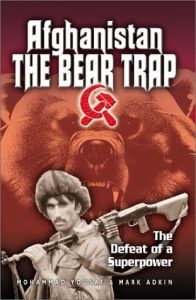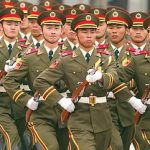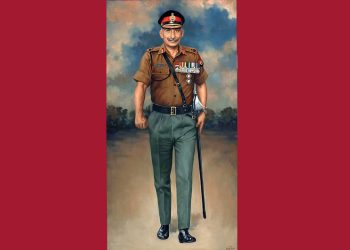
The Bear Trap (Afghanistan Untold story) was written down by Mohammad Yousaf a retired brigadier under Pakistan Army along with his friend Mark Adkin, a former military officer, who authored several other books on military history in Britain. The book was originally written in 1992. This book is extensive documentation by the author in a nonlinear writing style and contains his accounts of operation and observation in Afghanistan under Soviet invasion when posted as an Inter-services Intelligence (ISI) Director in the Afghan bureau. He has penned his four years of service from 1983 to 1987 for Afghanistan’s independence and acknowledged the countless efforts by the mujahedeen, ISI, and the CIA in the book. Several prominent figures who played a massive role in the Afghanistan war have been mentioned in the book. The chapters of the book are divided into 17 parts apart from the introduction and the postscript. The author claimed the writings in his book as not done through diverse references and works of a journalist but entirely based on his own experience, he justified this statement by quoting “without first-hand knowledge of the condition in the battlefield, even the best analyst is apt to draw the wrong conclusion from the facts and figures”. The bear has been referred to in the book as the Soviet Union the second superpower of the time whose intimidating act of invading Afghanistan in 1979 had created havoc among the international system and endured the implications it was to inflict upon the neighboring state of Pakistan.
The book starts with an introduction part in which the author attempted to brief up about the objectives of the Soviet invasion in Afghanistan and uncovered the mujahedeen’s struggle against them. The author also mentions a vast responsibility, that he along with the ISI head General Akhtar Rehman Khan as a tactician and a strategist of the combat operations had to covertly implement against a large conventional force and the contribution of other countries to wage the war.
The first three chapters are the prolongation of the event that took place in 1988 leading to the death of Pakistan’s president Zia ul Haque and General Akhtar, Chairman of the Joint Chiefs of Staff Committee along with two US highest officials. According to the author, the plane crash could have been an act of sabotage or misadventure; by pinpointing abundant facts that turns writer’s attention towards this incident more as a conspiracy. Furthermore, Zia and Akhtar were the main architects of the successful risky operations in Afghanistan, that made the communist regime pull off from the region and earn a name for their military genius. Both the figures were assumed to be on the hit list of many people, organizations, and even nations following this thought the author elaborates on the possible suspects. Also, a lot of efforts to cover up this incident were witnessed like the lack of enthusiasm by the investigation committee in this case and the culprits were unknown to date.
The fourth chapter “The Beginnings” the book outlines the factors that necessitated Pakistan’s action and involvement in the Afghanistan war. Pakistan determined to have had an integrated planned defense system to counter the enemy and provide a base area to the mujahedeen, despite the fact, Pakistan never admitted publicly its support to the jihad cause. The author quoted General Akhtar’s saying that “Afghanistan could be made into another Vietnam, with the Soviets in the shoes of America”. The fifth and the sixth chapter was followed by author’s explanations about the strength and weakness of the mujahedeen and the Soviets and stated the geostrategic importance of Afghanistan, that would assuredly impact the outcome of the war. On the one hand, mujahedeen’s physical courage and the fervent religious belief in the cause of jihad made them glorious warriors but on the other, internal bickering among different parties and their inflexibility to change caused some serious complexities in formulating tactics. The author anticipates that the opponent’s Airpower and hold of important strategic borders and towns despite being their asset, the lack of interest in substantial additional formation to war could turn it in the mujahedeen’s favor.
The seventh chapter stated as “Another Vietnam”, draws the similarities between the Vietnam war with Afghanistan. It focuses on how both the wars involved superpowers by assisting their allies through arms supplies and reinforcement in the foreign lands. The Vietnam war proved to be an insulting defeat for America, so the guerrilla war in Afghanistan was expected as a potential cause for America to aid the mujahedeen with money, arms, and intelligence to run the war tactfully. The author even justifies in his book, how without the backing of America and other foreign powers it would have been difficult in pushing back the soviet bears from the land.
The eighth chapter “The role of the CIA”, ascertained how the war arrangements proceeded with America subheading the war. Americans spent millions of dollars to support mujahedeen by providing them with wide varieties of arms, ammunition, and equipment, but they were never directly involved in the war for avoiding operational chaos; so, the duty of arms distributions, training, and further-reaching in contacts with the party leader and the mujahedeen commanders was entrusted upon Pakistan. The author points out the fact that the complex engagement of these two nations in Afghanistan often led to disagreements between them on several occasions. Pakistan claimed the CIA’s incompetence in little understanding of battlefield conditions and sometimes supply of obsolete weapons caused the failure of many operations and posed a serious threat. However, this does not mean all the weapons proved to be inefficient until they started providing Stringer. The further chapters of the book went on to explain the training and tactics of the mujahedeen and covert operations carried out by them in Soviet bases of which some missions were conducted remarkably successfully but seldom led to severe casualties upon the civilians as well as the mujahids. The author also highlighted the strategic importance of Kabul as being the nerve center of the country.
The second last chapter “The Bear Back off” expounded on revealing unforeseen truths coming out with the Soviet withdrawal from Afghanistan. The author seeks to explain how mujahedeen on the brink of victory lost credibility in war. With the signing of the Geneva Accord in 1988, which seemed to settle the situation in Afghanistan, the US sought to change its motives. According to the author, the retreat of the communist regime was foreseen by the US as the Islamic fundamentalist government took over the city of Kabul. To prevent the situation molding in similar patterns like Iran, the US insisted Pakistan on forming an interim government with Najibullah in Afghanistan. The author expressed concerns over the egoistic decision by the west, resulting in Afghanistan remain the puppet in their hands and for this reason, it would escalate the catastrophe further in the country and will forever strive for peace and stability in the future.
The book is a deep dive into the unraveling history of Afghanistan war. The author’s main aim was to enlighten the readers with the limitless efforts put by the mujahedeen surviving the tough life during the war and supporting the resistance movement, but their ambition for an independent Afghanistan was never achieved. The concluding part illustrated how the nature of warfare in Afghanistan transformed from a military perspective into political chaos since the US decided to bring about the stalemate, it didn’t do justice to the mujahedeen’s hard work. At last, the author predicts the future outcomes of the political compromise imposed on Afghanistan after the end of the war.














